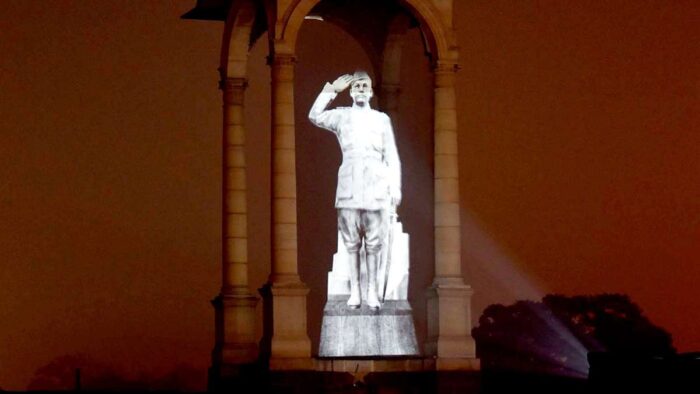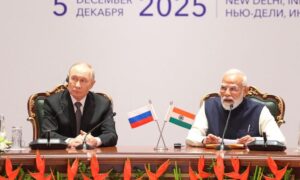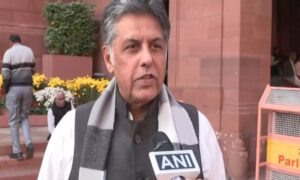
Picture : Twitter / ANI
Last Sunday, the 23 of January, the 125th Birth anniversary of Netaji Subhas Chandra Bose will go down in history as the day when the Prime Minister Narendra Modi unveiled by pressing the button the holographic representation of the statute of Netaji Subhas at the India Gate canopy where till 1968 stood the statue of King Emperor George the Fifth of the British Raj . It was indeed the symbol of the extractive colonial state that ” drained away” India’s wealth for close to 200 years and left her impoverished which is so well documented by authors from Romesh Chandra Dutt in Economic History of India to William Dalrymple in Anarchy. In due time a granite statue of over 28 feet will be installed at this very canopy , the PM announced on this day to the nation.
India pays tribute to Netaji Subhas Chandra Bose pic.twitter.com/PrnEIQdlIu
— Narendra Modi (@narendramodi) January 23, 2022
It thrilled the hearts of every patriotic Indian all over the world and especially the veterans of the INA – The Azad Hind movement and Indian National Army all over South and East Asia in Japan, Pakistan, Bangladesh, Myanmar, Malaysia, Singapore and elsewhere in Asia. The reasons for jubilation are many and complex: First, it was not expected because for years efforts were made with state patronage- a point the PM Modi made in his address to the nation to the deliberate underestimation of role of the INA and Netaji Subhas Chandra Bose and other leaders in compelling the British to leave India. And such efforts by” official history writers” nearly succeeded in projecting to generations of Indians that the British left only because of the non violent movement led by Gandhiji despite the hard evidence which includes a statement of Clement Atlee, the British Prime Minister at the time when the transfer of power was being considered.
Lord Atlee affirmed in a conversation with Justice Mukherjee of Calcutta High court during his visit to Calcutta later that it was the impact of the of war Netaji’s Azad Hind Fauz launched against the British in the form of rebellions of the Indian Armed Forces after the war in several places in India that compelled the British to leave. He even stated that the impact of the 1942 August movement on the British power in India was ” minimal” . And, because the British Raj was founded on the loyalty of the Indian army ,and as the British were unable to face a mutiny, the decision to leave India was taken. However despite all these efforts the memory of Netaji and the INA remained alive in the hearts of Indians in every corner of India which found expressions in different ways. As for instance I saw a portrait of Netaji at many places on the same pedestal with Maharana Pratap , Chhatrapati Shivaji Maharaj and Maharaja Ranjit Singh.
However it was PM Modi who by inviting the INA veterans in 2019 to take part in the Republic day Parade at New Delhi and by observing the 75 th Anniversary of the formation of the Azad Hind Government at the Red Fort on October 21,2018 began the act of ending misperceptions of our freedom struggle. In this background, the decision of the government of India to put in place a statue of Netaji in full military uniform as the Head of the Azad Hind Government covering the British India that included Bangladesh and Pakistan as well at the very canopy where stood the statue of the British monarch is the most fitting tribute to Netaji Subhas and about 26000 INA soldiers who laid down their lives in fighting the British in the fierce battlefields of Mayanmar and in the North East India at Kohima and Imphal. And that it was announced on the 125 th Birth anniversary of Netaji as also the decision that the Republic day celebrations will now begin from the observance of Netaji’s birthday anniversary on January 23 as the Parakram Diwas will gladden the hearts of millions of people.
In all these developments which came really as a surprise, I see the hand of God, the spiritual force that guides and shapes the destiny of Nations because nothing else could explain why the” canopy” at the India Gate remained empty for over half a century as though it was waiting for installation of Netaji’s statute. It’s not that there were no thoughts of placing the statute of other leaders for this prime location – a replica of Arc de Triumph of Paris right on Rajpath- the Kingsway of the British period , and yet it remained empty. Now this was really providential. Thus the Government decision to install Netaji’s statute at this historic canopy is to me and countless Indians manifestation of the divine will and justice.
And this must be the beginning of a new ” Discovery of India” in the 21st century as we should revisit the whole narrative of our struggle for freedom . There is a lot of work in this field, as for instance, the appreciation of the agitation against Rowlatt Act. In the standard school and College textbooks a reference to the Rowlatt Act is made only in connection with the agitation that Gandhiji led demanding its repeal and nothing about the contents of Report of the Sedition Committee that Justice Rowlatt chaired nor the circumstances which caused the British government to constitute the High Power Committee were even mentioned in the text books. Most students and the teachers may not know even the title of the Rowlatt Act and its stated object ie to suppress the” revolutionary and anarchical activities ” inspired by strong Hindu religious cult of Shakti and Goddess Kali. The fact that the Report made a reference to the work of Swami Vivekananda, Sri Aurobindo and VD Savarkar and the most serious threat the activities of revolutionary groups in Maharashtra, Bengal and Punjab and Madras Presidency posed to the continuation of the British Raj find no mention in the standard text books. No wonder that most students wouldn’t even know that Justice Rowlatt was a British judge especially engaged to preside over the committee to examine the nature and extent of the threats to the British rule posed by “revolutionary activities” and to recommend measures to suppress the same. The only explanation for this approach is to overstress the role of the nonviolent movement as if there was no real freedom movement before Gandhiji appeared in the scene with his” satyagraha” to mislead generations of Indians into believing that freedom was achieved by the nonviolent movement only. Naturally a proper appreciation of the role of Netaji Subhas Chandra Bose and the war the INA waged against the British by Provisional Government of Azad Hind of the British India would go against this narrative.
It is hoped that the academic community will take a serious notice of the Prime Modi’s observation on this larger issue of lack of objectivity in studies of our freedom struggle and make earnest research work to place on record the great contributions of other groups of patriots across the country to the cause of national freedom. This may be the best way to pay homage to the memory of Netaji Subhas Chandra Bose and the valiant soldiers of the Azad Hind Government who laid down their lives to the cause of national freedom.
[the_ad id=”41103″]


















